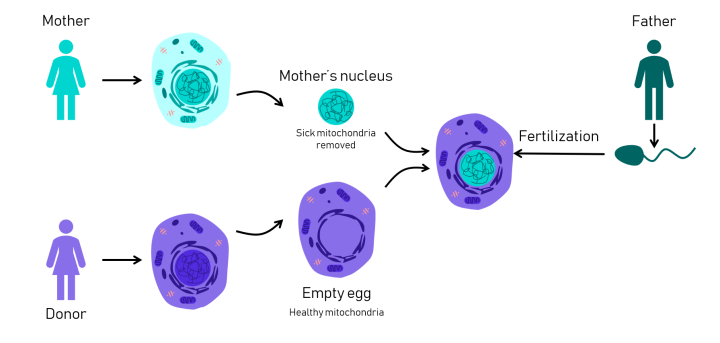Mitochondrial Donation Treatment
Context:
- A baby was born in the United Kingdom utilising the DNA of three different people. The infant technically has three parents since, in addition to receiving mitochondria from a donor, it also receives DNA from its biological parents.
- To make this possible and prevent the child from acquiring the mother’s mitochondrial illness, cutting-edge technology was deployed.
What are mitochondria?

- Almost all human cells, including eggs, have mitochondria. They generate the majority of a cell’s energy, which fuels every organ and system in our body.
- Any cell must have properly functioning mitochondrial genes in order to operate. Mitochondrial disease is a term used to describe serious medical conditions caused by mitochondria with faulty genes.
What does mitochondrial donation treatment involve?
- Maternal spindle transfer (MST) and pronuclear transfer (PNT) are two methods for mitochondrial donation that have been created and approved by Parliament.
- In both methods, healthy donated mitochondria and your nuclear genetic material (the genes that make you who you are) are used to form eggs or embryos.
- Your nuclear genetic material is taken out of your eggs during MST and transplanted into eggs that were given but had their nuclear genetic material taken out. Embryos are then produced by fertilising the eggs with sperm.
- In PNT, sperm and your eggs are fertilised in a lab to produce embryos. Then, the sperm donor’s donated sperm and donated eggs are used to make new embryos, and the nuclear genetic material from each embryo is transferred into those new embryos. Again, the given eggs won’t have any nuclear genetic material.
- The resulting embryos in both MST and PNT would have genetic DNA from you and your spouse (or sperm donor), making them your biological children. Both methods are equally effective.
Legality Around The World
- The use of MDT, also known as mitochondrial replacement therapy (MRT), is permitted by certain legal regulations in the United Kingdom.
- The law was changed in 2015 to allow the technique, and in 2017, the Newcastle Fertility Centre became the first facility to be granted a licence to carry out MDT.
- According to the information available, there have been at least 30 cases of MDT that have been approved by the Human Fertilisation and Embryology Authority (HFEA) in the UK.
Side Effects
In terms of potential negative effects, it’s possible that a tiny number of defective maternal mitochondria could unintentionally be transferred during the process. Although there aren’t many hazards, more published data and research are required to reach a consensus and learn more about the long-term effects and potential problems of MDT.




